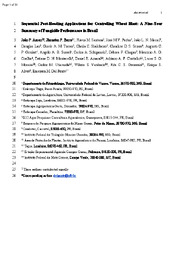Sequential post-heading applications for controlling wheat blast: a nine-tear summary of fungicide performance in Brazil.
Sequential post-heading applications for controlling wheat blast: a nine-tear summary of fungicide performance in Brazil.
Author(s): ASCARI, J. P.; BARRO, J. P.; SANTANA, F. M.; PADUA, J. M. V.; MACIEL, J. L. N.; LAU, D.; TORRES, G. A. M.; SBALCHEIRO, C. C.; SEIXAS, C. D. S.; GOULART, A. C. P.; SUSSEL, A. A. B.; SCHIPANSKI, C. A.; CHAGAS, D. F.; COELHO, M. A. O.; MONTECELLI, T. D. N.; AMARAL, D. R.; CUSTÓDIO, A. A. P.; MOREIRA, L. S. O.; UTIAMADA, C. M.; VENÂNCIO, W. S.; GOUSSAIN, R. C. S.; ALVES, K. S.; DEL PONTE, E. M.
Summary: Wheat blast, caused by Pyricularia oryzae Triticum (PoT) lineage, is a major constraint to wheat production, mainly in the tropics of Brazil where severe epidemics have been more frequent. We analyzed disease and wheat yield data from uniform field trials conducted during nine years (2012 to 2020) in order to assess whether the percent control and yield response were influenced by fungicide type, region (tropical or subtropical), and year. Six treatments were selected, all evaluated in at least 19 trials. Two ungicides were applied as solo active ingredients: MANCozeb, and TEBUconazole, and four were premixes: AZOXystrobin + TEBU, TriFLoXystrobin + PROThioconazole, TFLX + TEBU, and PYRAclostrobin + EPOXiconazole. Percent control, calculated from back- ransforming estimates by a meta-analysis network model fitted to the log of the means, ranged from 43 to 58%, with all but PYRA + EPOX showing efficacy greater than 52% on average, not differing among them. The variation in both efficacy and yield response was explained by region and all but TEBU performed better in the subtropics Than in the tropics. Yield response from using three sequential sprays was around two times greater in the subtropics (319 to 532 kg/ha) than in the tropics (149 to 241.3 kg/ha). No significant decline in fungicide efficacy or yield response was observed in nine years of study for any of the fungicides. Our results reinforce the need to improve control by adopting an integrated management approach in the tropics given the poorer performance and lower profitability, especially for the premixes, than in the subtropics. Keywords: Pyricularia oryzae, chemical control, profitability, meta-analysis
Publication year: 2021
Types of publication: Journal article
Unit: Embrapa Wheat
Keywords: Chemical control, Meta-analysis, Profitability, Pyricularia Oryzae
Observation
Some of Embrapa's publications are published as ePub files. To read them, use or download one of the following free software options to your computer or mobile device. Android: Google Play Books; IOS: iBooks; Windows and Linux: Calibre.
Access other publications
Access the Agricultural Research Database (BDPA) to consult Embrapa's full library collection and records.
Visit Embrapa Bookstore to purchase books and other publications sold by Embrapa.

